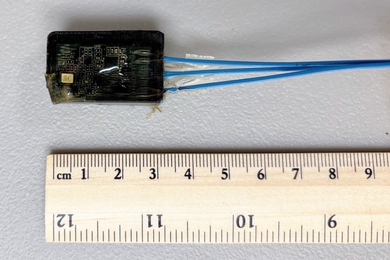The Department of Linguistics and Philosophy is unveiling a recently installed $2 million to $3 million magnetoencephalography system (MEG) built at MIT by the Kanazawa Institute of Technology (KIT).
The MEG system is housed in the KIT/MIT/MEG Joint Research Laboratory in Building E10 at 79 Amherst St., where dedication ceremonies will be held today.
MIT and KIT established the joint operation last July. Professor Alec Marantz of linguistics and philosophy is the laboratory's research director.
The system, which was developed at the MATTO Laboratory for Human Information Systems at KIT in Nonoichi, Ishikawa, Japan, was shipped here and erected on site by KIT. To provide the 500 square feet needed to accommodate the magnetically shielded system, MIT broke through a wall and consolidated Rms E10-043 and E10-044. The space was provided by the Department of Brain and Cognitive Sciences.
The MEG system employs superconducting quantum interference devices (SQUIDs) to create extremely sensitive magnetometers that make possible the fine-tuned monitoring of neuronal activity in the brain.
MIT initially will use the equipment in experiments that involve speech perception and visual word recognition, according to Professor Marantz, who noted that faculty and students from brain and cognitive sciences will work alongside linguistics researchers in the lab.
"The establishment of this human brain imaging lab at MIT within the Department of Linguistics and Philosophy reflects the department's vision of the close relationship between linguistics and cognitive neuroscience," Professor Marantz said.
The first MEG system using a shielded room was operated at the Francis Bitter Magnetic Laboratory for for many years, under the direction of group leader David Cohen, a pioneer in the field of magnetoencephalography. Dr. Cohen, who is considered the inventor of the MEG system, started phasing out the operation three years ago, and the room was recently dismantled.
Faculty and researchers from MIT and KIT will be at the dedication of the KIT/MIT Laboratory and at a subsequent reception in the Faculty Club.
A version of this article appeared in MIT Tech Talk on December 17, 1997.





